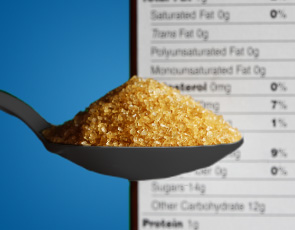An essential aspect of good health is understanding what’s in the food you eat. Excellent ways to do this are to carefully read labels of the food you buy at the grocery store and to go to restaurants that list nutritional facts and ingredients.
Top 8 Things to Look for on a Food Label:
1. SUGAR
Whether it’s listed as “High Fructose Corn Syrup,” “Concentrated Sugar,” or any ingredient that ends in “-ose,” there’s sugar in what you’re eating. Try to find products with less sugar or lower it yourself.
- Drinks – Did you know there is almost as much sugar in orange juice as soda? Unlike soda, you can add 1 part water to 2 parts juice, reduce the sugar by 1/3, and still have a delicious and nutritional drink!
- Desserts – When it comes to desserts, choose fruit or use a baby spoon. You’ll eat just as many bites, keep the sensational flavor of the dessert, but eat fewer additional calories.
Read “High-Fructose Corn Syrup Propaganda” on pilladvised.com
2. SALT/SODIUM
Most people get their sodium from processed foods, not from a salt shaker. Read the food label. You should aim for less than 2,500 milligrams of sodium per day, which breaks down to less than 600 milligrams for main dishes. As a general rule, avoid foods where the number of milligrams of sodium is higher than the number of calories.
Read “Hold the Salt” on pilladvised.com
3. “GOOD” FATS
Polyunsaturated and monounsaturated are healthy forms of fat. Cooking with olive oil instead of butter or eating a handful of nuts are great ways to get these ‘good fats’. Omega-3 fatty acids are a particularly healthy type of these ‘good fats’ which you can get from walnuts, soy, flax, fatty fish like salmon, as well as health bars and drinks. Try to get 1/2 gram of omega-3 fatty acids each day – and if you have heart problems, double up to 1 gram.
Read “Supplement Your Knowledge of Omega Fats” on pilladvised.com
4. “BAD” FATS
- Trans Fats Avoid trans fats whenever possible. They cause 10 times the damage to the heart as saturated fats, and have no nutritional value. Anything that says “partially hydrogenated” or “hydrogenated” on the food label means it contains trans fats, even when the package says “No trans fats”. Food companies are permitted to say “No trans fats” if the food has less than 0.5 grams trans fats per serving. While that might not seem like much, most people use several servings of Coffee-mate (non-dairy coffee creamer) each day. Although manufacturers can say “No trans fats”, did you know that the first ingredient in the ingredient list is ‘vegetable oil containing partially hydrogenated coconut or palm kernel oil and hydrogenated palm oil’? All trans fats! If you drink 2 cups of coffee each day and put two packets (two tablespoons) in each cup, you could theoretically find yourself drinking up to two grams of trans fats every day.
- Saturated Fats Primary sources of these fats are from animal products such as meat and dairy. As a general rule, you want to eat less than 10% of your calories from saturated fats – this equals about 27 grams of saturated fat in a 2100 calorie diet. For example, a 10 oz prime rib has 45grams, a 20 oz filet mignon has 22grams, 9 oz chicken breasts has 6 grams, and 7 oz grilled salmon has 2g
5. FIBER
Look for products that have fiber, in general more is better. Aim to get at least 20 grams of fiber a day.
Read “A Tale of Two Fibers” on pilladvised.com
6. GRAINS
Products list wheat products in many ways (enriched, unbleached, wheat, etc.). However, unless it says “whole wheat”, the grain in the product is a white grain and is not as good for you as whole grain.
7. SERVING SIZE
Often your idea of a serving size isn’t the same as the manufacturer’s. For example, if you drink 12 ounces of juice every morning, but the serving size is 8 ounces, then every number on the label needs to be adjusted accordingly –thus, multiplied by 1.5.
8. CALORIES
Depending on whether you are trying to maintain your weight, lose or gain weight, keep an eye on the number of calories you eat – and keep a running tally on the calories you consume in a day. Your daily calorie needs should dictate how many calories you take in over the course of a day.
If all else fails, a good rule of thumb is the shorter the ingredient list the better. The longer the list of ingredients, the greater chance of more bad fats, salt, and sugar.

